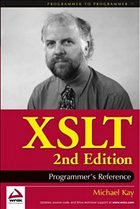Who is this book for?
This book is for programmers who want to learn how to use the XSLT language for developing web applications. The book is in four parts: a detailed introduction to the concepts of the language, a reference section giving comprehensive specifications and working examples of every feature, a development guide giving design advice and case studies for the advanced user, and a product reference detailing the features and usage of the latest versions of Microsoft MSXML, Apache Xalan, Oracle XML, open source Saxon, the TRAX API and other processors and tools.
What does this book cover?
* Explains the rationale behind XSLT: what is it for?
* Describes the XSLT processing model
* Explores design patterns and stylesheet structure
* Provides a full reference to the XPath and XSLT languages
* Demonstrates the use of XSLT with worked examples
* Describes currently available XSLT processors - updated to reflect recent advances in XSLT parser technology
* Includes coverage of proposed specification enhancements
As an experienced developer, you need to get the facts on a new technology fast. Without the marketing hype, without the trivial introduction. That's what Wrox Programmer's References deliver. Hard facts on the newest technologies with practical examples of how to apply new tools to your development projects today.
Introduction.
Chapter 1. XSLT in Context.
Chapter 2. The XSLT Processing Model.
Chapter 3. Stylesheet Structure.
Chapter 4. XSLT Elements.
Chapter 5. Expressions.
Chapter 6. Patterns.
Chapter 7. Functions.
Chapter 8. Writing Extension Functions.
Chapter 9. Stylesheet Design Patterns.
Chapter 10. Worked Examples.
Appendix A. Microsoft MSXML3.
Appendix B. Oracle.
Appendix C. Saxon.
Appendix D. Xalan.
Appendix E. Other Products.
Appendix F. TrAX: The Transformation API for XML.
Glossary.
Index A - Elements.
Index B - Functions.
Index C - General.
This book is for programmers who want to learn how to use the XSLT language for developing web applications. The book is in four parts: a detailed introduction to the concepts of the language, a reference section giving comprehensive specifications and working examples of every feature, a development guide giving design advice and case studies for the advanced user, and a product reference detailing the features and usage of the latest versions of Microsoft MSXML, Apache Xalan, Oracle XML, open source Saxon, the TRAX API and other processors and tools.
What does this book cover?
* Explains the rationale behind XSLT: what is it for?
* Describes the XSLT processing model
* Explores design patterns and stylesheet structure
* Provides a full reference to the XPath and XSLT languages
* Demonstrates the use of XSLT with worked examples
* Describes currently available XSLT processors - updated to reflect recent advances in XSLT parser technology
* Includes coverage of proposed specification enhancements
As an experienced developer, you need to get the facts on a new technology fast. Without the marketing hype, without the trivial introduction. That's what Wrox Programmer's References deliver. Hard facts on the newest technologies with practical examples of how to apply new tools to your development projects today.
Introduction.
Chapter 1. XSLT in Context.
Chapter 2. The XSLT Processing Model.
Chapter 3. Stylesheet Structure.
Chapter 4. XSLT Elements.
Chapter 5. Expressions.
Chapter 6. Patterns.
Chapter 7. Functions.
Chapter 8. Writing Extension Functions.
Chapter 9. Stylesheet Design Patterns.
Chapter 10. Worked Examples.
Appendix A. Microsoft MSXML3.
Appendix B. Oracle.
Appendix C. Saxon.
Appendix D. Xalan.
Appendix E. Other Products.
Appendix F. TrAX: The Transformation API for XML.
Glossary.
Index A - Elements.
Index B - Functions.
Index C - General.

